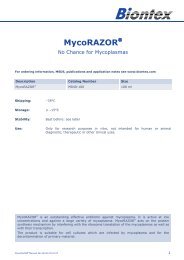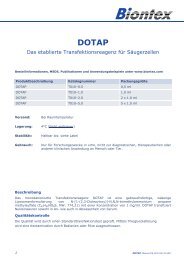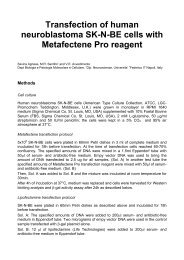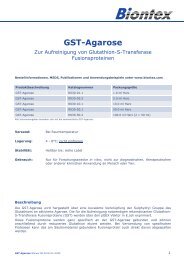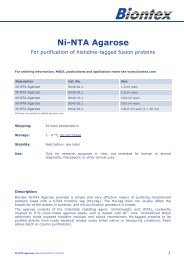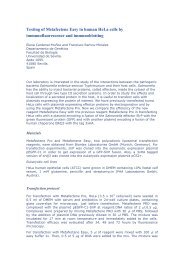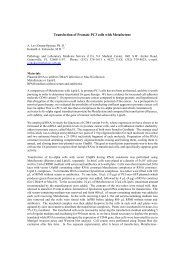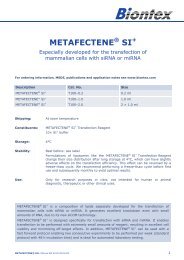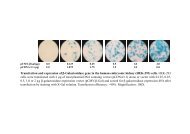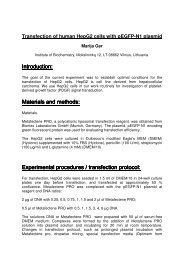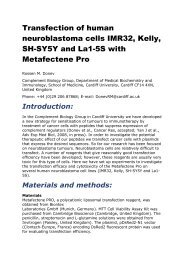Evaluation Metafectene Pro[1] revSI - Biontex Laboratories
Evaluation Metafectene Pro[1] revSI - Biontex Laboratories
Evaluation Metafectene Pro[1] revSI - Biontex Laboratories
You also want an ePaper? Increase the reach of your titles
YUMPU automatically turns print PDFs into web optimized ePapers that Google loves.
culture plate. At the same time, Lipofectamin, Dharmafect 1, Dharmafect 2, Dharmafect 3 andDharmafect 4 were complexed with the pCMV-EGFP plasmid at the reagent: DNA ratio respectively of4 µl:1.5 µg for Lipofectamin and 2.5 µl:1.5 µg for the 4 Dharmafect reagents. Complexes wereprepared by mixing the appropriate amount of lipofection reagent diluited in 100 µl of Optimem with1.5 µg of plasmid diluited in the same volume of medium. As described above for <strong>Metafectene</strong>-<strong>Pro</strong>,the mixture was incubated at room temperature for 20 minutes and then 0.2 ml of the solution wasadded drop by drop to each well of the culture plate. After 5 hours, the transfection mixture wasremoved and replaced with RPMI 1640 supplemented with 10% FCS, 1% HEPES, L-Glutamine 2mMmedium and 1% antibiotics-antimycotic mix (Gibco-BRL, Grand Island, NY). After 48 hours the cellswere analysed at the cytofluorimeter for the expression of the reporter gene EGFP in order to estimatethe efficiency of the transfection procedure.Results and discussion:The lipofection was performed with different reagents in order to test the efficiency of differentprocedures in transferring the reporter plasmid pCMV-EGFP to our cell line.As the cytofluorimetric analysis shows, with <strong>Metafectene</strong>-<strong>Pro</strong> we obtained the highest percentage oftransfected cells (33%) measured as the percentage of cells EGFP-positive (Fig.1). In comparison,with all the other reagents tested we couldn't obtain more than 16% of transfection efficiency.Moreover with some reagents (Dharmafect 1) we observed some cytotoxicity measured as analteration of the morphologic cytofluorimetric parameters FS-SS and evident at the microscopicobservation of the cells. On the contrary, with <strong>Metafectene</strong>-<strong>Pro</strong> we didn't detect any cyotoxic effectsboth the day after transfection and later on (Fig.2).Conclusion / summary:Jurkat is a human ATCC cell line derived from a T-ALL patient. Like most of the cells which grow insuspension, Jurkat are in general more difficult to transfect than cell lines growing in adherence. Onthe whole we can conclude that <strong>Metafectene</strong>-<strong>Pro</strong> in our system gave the best results in terms oftransfection efficiency. The percentage of cells transfected with <strong>Metafectene</strong>-<strong>Pro</strong> (33%) wassufficiently high to detect the expression of the reporter gene luciferase by a luminometer insubsequent experiments (not shown).Appendix: Tables and/or figures:f
Lipofection of Jurkat cell line(Efficiency of transfection)4030% EGFP+ cells20100NT<strong>Metafectene</strong>LipofectaminDarmafect 1Darmafect 2Darmafect 3Darmafect 4ReagentsFig.1. Cytofluorimetric analysis of the percentage of cells EGFP-positive after lipofection with differentreagents.
Lipofection of Jurkat cell line(Viability)10080% viable cells6040200NT<strong>Metafectene</strong>LipofectaminDarmafect 1Darmafect 2Darmafect 3Darmafect 4ReagentsFig.2. Percentage of viable cells based the morphologic citofluorimetric parameters FS and SSestimated 48 hours after transfection of Jurkat cell line with different lipofection reagents.MG/SI


![Evaluation Metafectene Pro[1] revSI - Biontex Laboratories](https://img.yumpu.com/50763611/1/500x640/evaluation-metafectene-pro1-revsi-biontex-laboratories.jpg)
